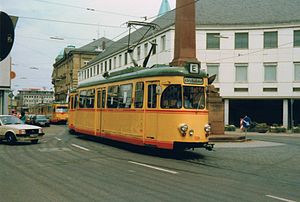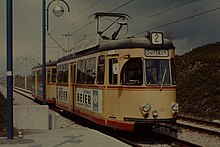VBK T4-EP
| T4-EP / B4-EP | |
|---|---|
|
T4-EP at Rondellplatz in 1993
|
|
| Numbering: | 134–141 (T4-EP), 434–441, earlier 309–316 (B4-EP) |
| Number: | 8 T4-EP, 8 B4-EP |
| Manufacturer: | Waggonfabrik Rastatt , Kiepe / BBC / SSW |
| Year of construction (s): | 1958-1961 |
| Retirement: | 1985-1987 |
| Axis formula : | B'B '(T4-EP), 2'2' (B4-EP) |
| Type : | Four-axle large-capacity railcar (T4-EP), four-axle large-capacity trailer car (B4-EP) |
| Gauge : | 1435 mm ( standard gauge ) |
| Length over coupling: | 14,960 mm |
| Length: | 14,100 mm |
| Height: | 3,150 mm |
| Width: | 2,374 mm |
| Trunnion Distance: | 6,000 mm |
| Bogie axle base: | 1,800 mm |
| Empty mass: | 18.4 t (T4-EP), 12.5 t (B4-EP) |
| Top speed: | 60 km / h |
| Hourly output : | 2 × 110 kW (134–137), 2 × 120 kW (138–141) |
| Power system : | 750 volts direct current |
| Power transmission: | Overhead line |
| Number of traction motors: | two |
| Drive: | DC motor (only T4-EP) |
| Brake: | Resistance brake, compressed air spring accumulator brake, link magnet rail brake |
| Train heating: | electric |
| Control: | electro-pneumatic contactor control |
| Coupling type: | BSI compact coupling |
| Seats: | 29 (T4-EP), 30 (B4-EP) |
| Standing room: | 89 (T4-EP), 100 (B4-EP) |
| Floor height: | 880 mm |
The railcars T4-EP and the sidecar B4-EP of Verkehrsbetriebe Karlsruhe (VBK) were a series of 16 tram cars in large-capacity construction , which were delivered in 1958 and 1961 by the Rastatt wagon factory for use in the Karlsruhe tram network. The large capacity cars were taken out of service between 1985 and 1987. Some cars were then converted into special vehicles.
construction
technology
The vehicles were four-axle open-plan cars in one-way design. They had conventional bogies made by Duewag . The car bodies were self-supporting, torsionally rigid, welded steel structures. They received double folding doors of the Duewag design in the middle of the vehicle and at the rear and a single folding door at the front. The windows were divided, the upper part was designed as a yellowish tinted vent window.
The vehicles differ from the vehicles T4 of the first and second delivery series in terms of their vehicle width. At 2.37 meters, they were 20 centimeters wider and were therefore also called wide-space cars . The wider car body also changed the front of the vehicles. While the T4 railcars had two headlights on top of each other, the T4-EP had them next to each other.
The two motorized bogies of the wagons were equipped with a Duewag tandem drive. The two traction motors each had an output of 110 kW. The vehicles had an electropneumatic control system that enabled multiple traction with each other and with the articulated multiple units GT6-EP of the Karlsruhe transport company and the GT6-EP and GT8-EP of the Albtal-Verkehrs-Gesellschaft . Power was supplied via pantographs. The vehicles were equipped with resistance brakes, compressed air spring-loaded brakes and magnetic rail brakes. BSI compact couplings were used to connect motor coaches and sidecars , with the electrical connection being made using a separate cable.
inner space
The interior had 2 + 1 row seating with tubular steel chairs and wooden seats and backrests. In addition to the fully equipped driver's seat, the rear of the railcar and the sidecar also had a shunting control panel that was built into a switch cabinet. In addition, until the end of the 1960s, the cars had a conductors seat at the rear entrance. After the introduction of one-man operation, this was removed. For one-man operation, ticket validators were installed near the doors. Line number boxes attached to the front and rear, an additional target film display at the front and side sign boxes were used for passenger information.
Coloring
The vehicles were painted in the Karlsruhe city colors yellow with a wide red decorative line all around below the windows. Several aluminum moldings ran around the vehicle. This painting was slightly changed in the 1970s by adding a second, thin decorative line to the red decorative line and also painting the apron of the car body red. The aluminum trim was omitted. The area below the window was initially decorated with the Karlsruhe city arms. After the introduction of side wall advertising, this was dropped.
history
delivery
At the end of the 1950s, the Karlsruhe tram fleet consisted exclusively of two-axle railcars and sidecars and the T4 and B4 open-plan cars. In 1958, the Karlsruhe transport company procured another eight railcars with the T4-EP and in 1961 with the B4-EP again as many sidecars. These cars were 20 centimeters wider than the cars of the first delivery series and differed in their electrical equipment. The electrical equipment of railcars 134-137 came from Kiepe Electric , that of railcars 138-141 from BBC and that of the trailer from Siemens-Schuckertwerke . Although the vehicles proved their worth, further procurement was dispensed with in favor of the larger articulated multiple units GT6-EP , GT6-D and GT8-D .
commitment
The railcars usually ran in a two-car train with the appropriate four-axle trailer. The railcars with sidecars were always paired as follows: 134 to 309, 135 to 310, 136 to 311, 137 to 312, 138 to 313, 139 to 314, 140 to 315, 141 to 316. In contrast to the other tram vehicles owned the T4-EP and its sidecar have EBO approval. This also made it possible to use it on the Albtalbahn , the later tram line A of the Karlsruhe tram . The electropneumatic control allowed multiple tractions with the articulated multiple units GT6-EP of the Karlsruhe transport company and the GT6-EP and GT8-EP of the Albtal-Verkehrs-Gesellschaft used on this line . After the sidecars 309–316 had been redesignated as 434–441, the assignment of motor coaches and sidecars was also recognizable from the 300 higher company number. The last main line of the wagons was line 2 (Durlach – Neureuter Straße) until 1983. After the line network had been converted and the GT6-80C light rail vehicles were delivered, the four-axle trains were withdrawn from service in 1984. The set consisting of motor coach 139 and trailer car 439 was used again on a regular service basis in the winter of 1986/87.
Conversions
- 134–137 - Installation of 120 kW motors.
- 134–141, 309–316 - Conversion to one-man operation by the Rastatt wagon factory (1968).
- 134–141 - Removal of the electrical attachment on the front coupling. This means that it is no longer suitable for multiple traction.
- 134–141 - Conversion to half-scissor pantographs on some cars.
- 134–141 - Some cars have been converted to pantographs with single-arm lower shears.
Retirement and whereabouts
Of the vehicles, two railcars and seven sidecars were scrapped in the mid-1980s, while the set of railcars 139 and 439 (formerly 314) remained as roadworthy museum cars. Two railcars were converted into party cars and received an interior with upholstered corners and a striking, red and white paintwork. In order to be able to use the vehicles in winter service, they received a second pantograph with a copper contact strip, which enables iced overhead lines to be scraped free. Three railcars were converted into towing cars for the railway maintenance department, which uses them to transport construction material to track construction sites. In the meantime, one of the party cars has been parked and two of the railway maintenance cars have been scrapped.
| dare | Continued use | scrapping |
|---|---|---|
| 134 | Catenary de-icing vehicle / party vehicle 490 since 1987 | 2013 |
| 135 | Railway maintenance vehicle 494 since 1986 | |
| 136 | Bahnmeisterei 492 work car since 1985 | 2011 |
| 137 | Bahnmeisterei 493 work car since 1985 | 1994 |
| 138, 312, 315 | 1987 | |
| 139, 314 | Museum car since 1985 | |
| 140, 313, 316 | 1985 | |
| 141 | Shunting car depot West / party car 491 since 1989 | |
| 309-311 | 1986 |
literature
- Manfred Koch (Ed.): Under power. History of local public transport in Karlsruhe. Badenia Verlag, Karlsruhe 2000, ISBN 3-7617-0324-4 ( publications of the Karlsruhe City Archives 20).
- Dieter Höltge: Trams and light rail vehicles in Germany. Volume 6: Bathing. EK-Verlag, Freiburg (Breisgau) 1999, ISBN 3-88255-337-5 .
- Martin Pabst: Paperback German streetcar railcars. Volume 2: Electric multiple units 1931 - today. Franckh'sche Verlagsbuchhandlung, Stuttgart 1982, ISBN 3-440-05043-2 .
- Axel Reuther: transition to articulated trolleys. The Karlsruhe open seating cars from the Rastatt wagon factory . In: Tram magazine . Volume 3, 2011, pp. 72-77 .
Web links
- Meeting point for local rail transport in Karlsruhe: Vehicle fleet list for trams - large-capacity multiple units / wide-area EP
- Meeting point for local rail transport in Karlsruhe: Car park list for trams - large sidecar / wide EP


